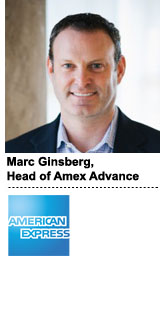
American Express on Tuesday launched a data-driven business division called Amex Advance.
Along with it Amex is debuting a data platform designed to let marketers run custom audience segmentation and predictive modeling against Amex’s own first-party data.
Amex Advance lets marketers and merchant partners use American Express’ database of deidentified cardholders to extrapolate insights about consumer spend and build better segments and lookalike models.
Although Amex data has been used to close the loop in marketing programs in the past, that data used to be limited to the company’s own cardholders and merchant network.
Now, through connections to third-party platform partners like Acxiom Audience Solutions, Wiland and Viacom, those insights can be applied to a broader consumer base beyond Amex’s cardholder network.
Amex audiences can be activated across channels and devices at national scale by these three distribution partners, as well as directly to publishers and advertisers via Acxiom’s LiveRamp.
So an advertiser can match its own first-party data and access segments based on consumer purchase histories, likelihood to purchase or life stage in the purchase funnel.
For instance, a pet food brand could narrow in on consumers considering purchasing a dog during the holiday season. Or, a home decor brand may find families looking to remodel their kitchen after a recent move.
Amex Advance, which is hosted in an environment encrypted by Acxiom, also allows an advertiser to combine deidentified purchase data with publishers’ second-party and third-party data sets, such as behavioral and geolocation data, Ginsberg said.
And Amex Advance lets advertisers predict their campaign performance.
 “Advertisers will be able to run models within a couple of hours to predict not only the likelihood of a consumer to spend money with their brand, but to understand the effectiveness of their campaigns using audiences as a benchmark versus traditional demographic targeting,” Ginsberg said.
“Advertisers will be able to run models within a couple of hours to predict not only the likelihood of a consumer to spend money with their brand, but to understand the effectiveness of their campaigns using audiences as a benchmark versus traditional demographic targeting,” Ginsberg said.
While Amex Advance is designed as a self-serve platform, a dedicated team of Acxiom employees runs managed services. In total, Amex Advance is staffed by a “couple dozen” employees, Ginsberg said.
“[Acxiom has] a big sales team that delivers marketing solutions to their clients, so they’re a partner in that sense,” Ginsberg said. “We provide the platform and they are sort of the conduit to the client to run campaigns using the platform, data and science we provide.”
Although Amex declined to share specifics, Ginsberg said at least 10-15 other partners in the data and advertising space are testing the solution.
“Think of it as a big data platform for creating [audience] models that can be used across multiple channels, including DMPs,” he said.
This post was syndicated from Ad Exchanger.

More Stories
Sex.life’s quickie to 1 million downloads
Draymond Green Addresses His ‘Questionable’ Choices in AT&T Ad
Netflix Announces New Ad Measurement Options Ahead Of The Upfronts